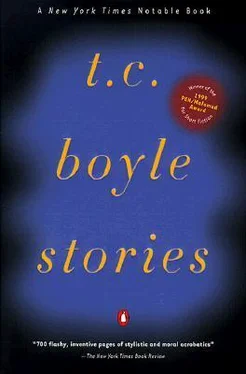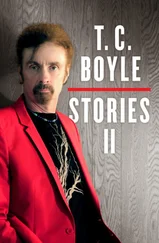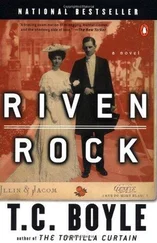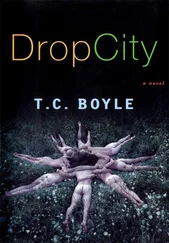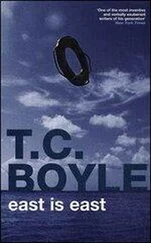T. Boyle - T. C. Boyle Stories
Здесь есть возможность читать онлайн «T. Boyle - T. C. Boyle Stories» весь текст электронной книги совершенно бесплатно (целиком полную версию без сокращений). В некоторых случаях можно слушать аудио, скачать через торрент в формате fb2 и присутствует краткое содержание. Год выпуска: 1999, Издательство: Penguin (Non-Classics), Жанр: Современная проза, на английском языке. Описание произведения, (предисловие) а так же отзывы посетителей доступны на портале библиотеки ЛибКат.
- Название:T. C. Boyle Stories
- Автор:
- Издательство:Penguin (Non-Classics)
- Жанр:
- Год:1999
- ISBN:нет данных
- Рейтинг книги:5 / 5. Голосов: 1
-
Избранное:Добавить в избранное
- Отзывы:
-
Ваша оценка:
- 100
- 1
- 2
- 3
- 4
- 5
T. C. Boyle Stories: краткое содержание, описание и аннотация
Предлагаем к чтению аннотацию, описание, краткое содержание или предисловие (зависит от того, что написал сам автор книги «T. C. Boyle Stories»). Если вы не нашли необходимую информацию о книге — напишите в комментариях, мы постараемся отыскать её.
T. C. Boyle Stories — читать онлайн бесплатно полную книгу (весь текст) целиком
Ниже представлен текст книги, разбитый по страницам. Система сохранения места последней прочитанной страницы, позволяет с удобством читать онлайн бесплатно книгу «T. C. Boyle Stories», без необходимости каждый раз заново искать на чём Вы остановились. Поставьте закладку, и сможете в любой момент перейти на страницу, на которой закончили чтение.
Интервал:
Закладка:
I just looked at her.
“Fields of them; Georgie, acres upon acres. Just think of the reflective power! Our moon, your moon — it’ll outshine that old heap of rock and dust ten times over.”
Mirrors. The simplicity of it, the beauty. I felt the thrill of her inspiration, pictured the glittering triumphant moon hanging there like a jewel in the sky, bright as a supernova, bright as the star of Bethlehem. No, brighter, brighter by far. The flash of it would illuminate the darkest corners, the foulest alleys, drive back the creatures of darkness and cut the crime rate exponentially. George L. Thorkelsson, I thought, light giver. “Yes,” I said, my voice husky with emotion, “yes.”
But Filencio Salmón, author of The Ravishers of Pentagord and my chief speech writer, rose to object. “Wees all due respet, Meeser Presiden, these glass globe goin’ to chatter like a gumball machine the firs’ time a meteor or anytin’ like that run into it. What you wan eeze sometin’ strong, Teflon maybe.”
“Not shiny enough,” Gina countered, exchanging a hurt look with Lorna. Obviously she hadn’t thought very deeply about the thing if she hadn’t even taken meteors into account. Christ, she was secretary for Lunar Affairs, with two hundred JPL eggheads, selenologists, and former astronauts on her staff, and that was the best she could come up with?
I leaned back in my chair and looked over the crestfallen faces gathered round the table — Gina, Lorna, Salmón, my national security adviser, the old boy in the Philip Morris outfit we sent out for sandwiches. “Listen,” I said, feeling wise as Solomon, “the concept is there — we’ll work out a compromise solution.”
No one said a word.
“We’ve got to. The world’s depending on us.”
We settled finally on stainless steel. Well buffed, and with nothing out there to corrode it, it would have nearly the same reflective coefficient as glass, and it was one hell of a lot more resistant. More expensive too, but when you’ve got a project like this, what’s a hundred billion more or less? Anyway, we farmed out the contracts and went into production almost immediately. We had decided, after the usual breast-beating, shouting matches, resignations, and reinstatements, on a shell of jet-age plastic strengthened by steel girders, and a façade — one side only — of stainless-steel plates the size of Biloxi, Mississippi. Since we were only going up about eighty thousand miles, we figured we could get away with a sphere about one-third the size of the old moon: its proximity to earth would make it appear so much larger.
I don’t mean to minimize the difficulty of all this. There were obstacles both surmountable and insurmountable, technologies to be invented, resources to be tapped, a great wealthy nation to be galvanized into action. My critics — and they were no small minority, even in those first few euphoric years — insisted that the whole thing was impossible, a pipe dream at best. They were defeatists, of course, like Colin (for whom, by the way, I found a nice little niche in El Salvador as assistant to the ambassador’s bodycount man), and they didn’t faze me in the least. No, I figured that if in the space of the six years of World War II man could go from biplanes and TNT to jets and nuclear bombs, anything was possible if the will was there. And I was right. By the time my first term wound down we were three-quarters of the way home, the economy was booming, the unemployment rate approaching zero for the first time since the forties, and the Cold War defrosted. (The Russians had given over stockpiling missiles to work on their own satellite project. They were rumored to be constructing a new planet in Siberia, and our reconnaissance photos showed that they were indeed up to something big — something, in fact, that looked like a three-hundred-mile-long eggplant inscribed at intervals with the legend NOVAYA SMOLENSK.) Anyway, as most of the world knows, the Republicans didn’t even bother to field a candidate in ‘88, and New Moon fever had the national temperature hovering up around the point of delirium.
Then, as they say, the shit hit the fan.
To have been torn to pieces like Orpheus or Mussolini, to have been stretched and broken on the rack or made to sing “Hello Dolly” at the top of my lungs while strapped naked to a carny horse driven through the House of Representatives would have been pleasure compared to what I went through the night we unveiled the New Moon. What was to have been my crowning triumph — my moment of glory transcendent — became instead my most ignominious defeat. In an hour’s time I went from savior to fiend.
For seven years, along with the rest of the world, I’d held my breath. Through all that time, through all the blitz of TV and newspaper reports, the incessant interviews with project scientists and engineers, the straw polls, moon crazes, and marketing ploys, the New Moon had remained a mystery. People knew how big it was, they could plot its orbit and talk of its ascending and descending nodes and how many million tons of materials had gone into its construction — but they’d yet to see it. Oh, if you looked hard enough you could see that something was going on up there, but it was as shadowy and opaque as the blueprint of a dream. Even with the telescope — and believe me, many’s the night I spent at Palomar with a bunch of professional stargazers, or out on the White House lawn with the Questar QM 1 Lorna gave me for Christmas — you couldn’t make out much more than a dark circle punched out of the great starry firmament as if with a cookie cutter.
Of course, we’d planned it that way. Right from the start we’d agreed that the best policy was to keep the world guessing — who wanted to see a piecemeal moon, after all, a moon that grew square by square in the night sky like some crazy checkerboard or something? This was no department store going up on West Twenty-third Street — this was something extraordinary, unique, this was the quintessence of man’s achievement on the planet, and it should be served up whole or not at all. It was Salmón, in a moment of inspiration, who came up with the idea of putting the reflecting plates on the far side, facing out on the deeps of the universe, and then swinging the whole business around by means of initial-thrust and retro-rockets for a triumphant — and politically opportune — unveiling. I applauded him. Why not? I thought. Why not milk this thing for everything it was worth?
The night of the unveiling was clear and moonless. Lorna sat beside me on the dais, regal and resplendent in a Halston moonglow gown that cost more than the combined gross product of any six towns along the Iowa-Minnesota border. Gina was there too, of course, looking as if she’d just won a fettuccine cook-off in Naples, and the audience of celebrities, foreign ambassadors, and politicos gathered on the south lawn numbered in the thousands. Outside the gates, in darkness, three-quarters of a million citizens milled about with spherical white-moon candles, which were to be lit at the moment the command was given to swing the New Orb into view. Up and down the Eastern Seaboard, in Quebec and Ontario, along the ridge of the Smokies, and out to the verge of the Mississippi, a hush fell over the land as municipalities big and small cut their lights.
Ferenc Syzgies, the project’s chief engineer, delivered an interminable speech peppered with terms like “photometric function” and “fractional pore space.” Anita Bryant sang a couple of spirituals, and finally Luciano Pavarotti rose to do a medley of “Moon River,” “Blue Moon,” and “That’s Amore.” Lorna leaned over and took my hand as the horns stepped in on the last number. “Nervous?” she whispered.
“No,” I murmured, but my throat had thickened till I felt I was going to choke. They’d assured me there would be no foul-ups — but nothing like this had ever been attempted before, and who could say for sure?
Читать дальшеИнтервал:
Закладка:
Похожие книги на «T. C. Boyle Stories»
Представляем Вашему вниманию похожие книги на «T. C. Boyle Stories» списком для выбора. Мы отобрали схожую по названию и смыслу литературу в надежде предоставить читателям больше вариантов отыскать новые, интересные, ещё непрочитанные произведения.
Обсуждение, отзывы о книге «T. C. Boyle Stories» и просто собственные мнения читателей. Оставьте ваши комментарии, напишите, что Вы думаете о произведении, его смысле или главных героях. Укажите что конкретно понравилось, а что нет, и почему Вы так считаете.
